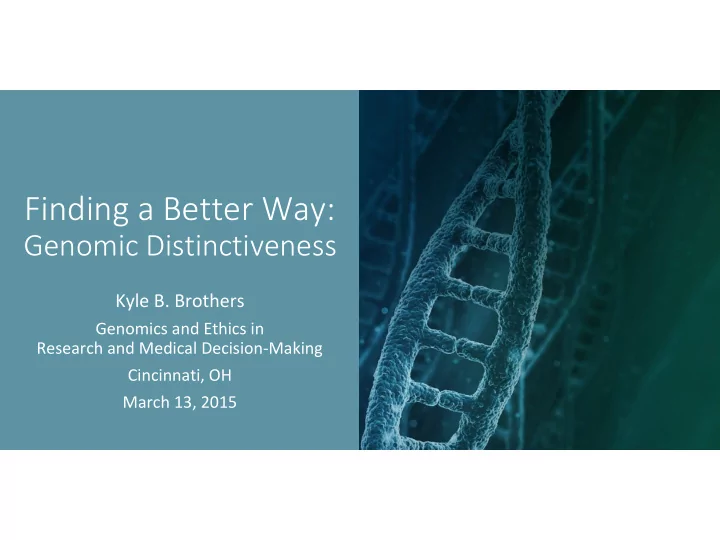

Finding a Better Way: Genomic Distinctiveness Kyle B. Brothers Genomics and Ethics in Research and Medical Decision-Making Cincinnati, OH March 13, 2015
• Debates over genomic exceptionalism Overview • Clinical analogies • Genomic Distinctiveness
Genomic Exceptionalism
Definitions • -ome = noun suffix indicating “all of the specified constituents of a cell, considered collectively or in total” • -omic = adjective suffix with same meaning
Genomic Exceptionalism • Large number of findings generated simultaneously • High likelihood of secondary finding
Genomic Exceptionalism Results may need filtering due to: • Genomics • Overwhelming number of secondary findings • Genetics • “Right not to know” • “Right to an open future”
Debate Over ACMG Recommendations
ACMG Recommendations “[W]e felt that clinicians and laboratory personnel have a fiduciary duty to prevent harm by warning patients and their families about certain incidental findings and that this principle supersedes concerns about autonomy, just as it does in the reporting of incidental findings elsewhere in medical practice .”
Critique of Recommendations “Rejecting the need for the patient’s informed consent to look for mutations in a predetermined list of 57 genes is a profound departure from prevailing law and norms .”
Response to Critique “To date, the traditions of genetic testing and reporting have exceptionalized all genetic risk information as potentially dangerous to the well- being of patients. This tradition, in the era of genome sequencing, must be reconsidered.”
Clinical Analogies
Imaging
Imaging Genomics • CT and MRI capture • WGS captures “whole” “whole” part of the body genome • High likelihood of incidental • High likelihood of secondary findings findings • Confirmation potentially • Confirmation potentially risky risky
Imaging Genomics • Images display incidental • Secondary findings are findings by default hidden by default • Filtering requires • Filtering can be achieved by sophisticated image narrowing analysis processing • “Incidental” • “Secondary”
Imaging Genomics • Incidental findings • Almost every patient has infrequent secondary findings • Narrow scope of possible • Potential for secondary findings findings related to every organ system
Imaging vs. Genomics • Similar in some ways, different in others • These differences could justify differences in practice
Newborn Screening
NBS Genomics • New technology (tandem • New technology (WGS) mass spec) provides cheap, provides cheap, easy easy alternative to multiple alternative to multiple existing technologies existing technologies • Also generates large • Also generates large number of results that were number of results that were not previously obtained not previously obtained
NBS Genomics • Many secondary findings • Many secondary findings reflect circumstances that reflect circumstances that are ambiguous – not clear- are ambiguous – not clear- cut pathology cut pathology • Confirmatory testing can • Confirmatory testing can take time, cause stress take time, cause stress
NBS Genomics • Results: • Results: • Reflect current metabolic • Reflect genetic state composition • Are proximal to clinical • Are distal from clinical signs and symptoms signs and symptoms • Reflect potential current • Typically reflect disease disease state risk
NBS Genomics • Typically performed: • Typically performed: • In public health setting • In research or clinical setting • On healthy patients • On patients with clinical indication • In infants • In adults or children
NBS vs. Genomics • Similar in some ways, different in others • These differences could justify differences in practice
Routine Laboratory Panels
Typical Laboratory Panels • Complete Blood Count: • Parameters for variety of cells in the blood • Basic Metabolic Panel: • 7-8 parameters reflecting fluid and electrolyte status • Complete Metabolic Panel: • BMP + liver and nutritional parameters
Routine Lab Panels Genomics • Laboratory devices generate • Secondary findings could be “package” of findings considered “part of the package” • Not practical to account for • Concerns about practicality of individual preferences in accounting for preferences components of package • Generates unexpected findings • Can generate unexpected that may need to be addressed findings that may need to be addressed
Routine Lab Panels Genomics • Limitations and implications • Limitations and implications still well understood poorly understood • “Package” is routinely filtered, • Concern that failure to analyze since laboratory devices can for important incidental findings generate more parameters than would be unethical requested
Imaging vs. Genomics • Similar in some ways, different in others • These differences could justify differences in practice
Antibiotic Sensitivities
Antibiotic Sensitivity Reports Genomics • Potential to generate large • Potential to generate large number of findings number of findings • Total number determined by • Total number determined by analytical decisions analytical decisions
Antibiotic Sensitivity Reports Genomics • Filtering is common practice; • Concerns about filtering sensitivities to expensive or include: restricted antibiotics are • Liability for not reporting suppressed to influence potentially useful information provider practice • Paternalistic laboratory practices
Antibiotic Sensitivities vs. Genomics • Similar in some ways, different in others • These differences could justify differences in practice
Genomic Distinctiveness
Dualist Perspectives Genomics is different, Genomics is the should be treated same, should be differently. treated the same.
Exceptionalism in Practice • In many debates, both sides accuse the other of exceptionalism • Most deny accusations of exceptionalism • Not useful for clarifying the issues
Distinctiveness • Every domains of medicine reflects distinctive traits • Each trait is shared with other domains • Unique combination of traits defines each domain
Genomic Distinctiveness Claim Identify Partial Practice Analogy Should Be The Same
Genomic Distinctiveness Determine Identify Relevant Decide on Implications Traits Practices of Traits
• Aaron Goldenberg • Nanibaa’ Garrison Thanks! • Rich Sharp • Jen McCormick
Recommend
More recommend